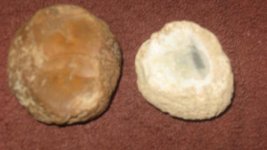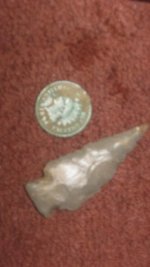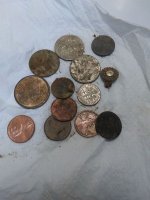You are using an out of date browser. It may not display this or other websites correctly.
You should upgrade or use an alternative browser.
You should upgrade or use an alternative browser.
Some sort of Scraper?
- Thread starter GroundS.KeepeR
- Start date
- Jan 27, 2009
- 18,716
- 11,709
- 🥇 Banner finds
- 1
- Detector(s) used
-
Tesoro Conquistador freq shift
Fisher F75
Garrett AT-Pro
Garet carrot
Neodymium magnets
5' Probe
- Primary Interest:
- All Treasure Hunting
haha I just posted on your other thread about that river,,, looks to be cores that they knocked the outside off to see what the material looked like on the inside. Do they show signs of being hit??
GroundS.KeepeR
Hero Member
- Thread starter
- #3
these were found in a total different place...alond {river}..the darker bigger one looks worked on both sides..TnMountains said:haha I just posted on your other thread about that river,,, looks to be cores that they knocked the outside off to see what the material looked like on the inside. Do they show signs of being hit??
- Jan 27, 2009
- 18,716
- 11,709
- 🥇 Banner finds
- 1
- Detector(s) used
-
Tesoro Conquistador freq shift
Fisher F75
Garrett AT-Pro
Garet carrot
Neodymium magnets
5' Probe
- Primary Interest:
- All Treasure Hunting
GroundS.KeepeR said:these were found in a total different place...alond {river}..the darker bigger one looks worked on both sides..TnMountains said:haha I just posted on your other thread about that river,,, looks to be cores that they knocked the outside off to see what the material looked like on the inside. Do they show signs of being hit??
These natural rocks are called spalls.They actually used them to knapp with also.The outside or the cortex I think is what its called is softer and would grab the chert when struck driving off flakes. The inside was also used when big enough to make tools. I have several round ones that were used in knapping and they have been recovered in woodland tool kits.
I think these were opened to see the material and may have been used some. If I am wrong some of these guys will chime in. They are pretty sharp. Nice finds many people ignore those type of items.

GroundS.KeepeR
Hero Member
- Thread starter
- #6
Ive learned alot from you with just little time! Im new at this ..But the funny thing if i see something that looks good/odd i keep it..thats just me..you just never know! heres my 1st arrow head i ever foundTnMountains said:GroundS.KeepeR said:these were found in a total different place...alond {river}..the darker bigger one looks worked on both sides..TnMountains said:haha I just posted on your other thread about that river,,, looks to be cores that they knocked the outside off to see what the material looked like on the inside. Do they show signs of being hit??
These natural rocks are called spalls.They actually used them to knapp with also.The outside or the cortex I think is what its called is softer and would grab the chert when struck driving off flakes. The inside was also used when big enough to make tools. I have several round ones that were used in knapping and they have been recovered in woodland tool kits.
I think these were opened to see the material and may have been used some. If I am wrong some of these guys will chime in. They are pretty sharp. Nice finds many people ignore those type of items.
Attachments
Th3rty7
Silver Member
hammetstones? I've heard that term before...do you know what they were used for Chuck?
ohio
Bronze Member
- May 28, 2007
- 1,039
- 21
Thirty7, they were used in percussion flaking or reduction of stone mass or knapping. I always find it strange that it is possible to knap flint with flint. I actually found three flint hammerstones on Saturday that look VERY similar to these. I sometimes take them home and put them in my flowerbeds or rockgarden. I will never forget the time, about ten years ago when I first started out, that I found a lovely hammerstone made of purple, black, and pink Boyle chert. It was almost perfectly round. I thought at the time that it was a natural nodule. I took it home eager to try to make a point. I knocked it with a masonry hammer a few times into some sizable spalls. It was not until later that I realized i had destroyed one of the better flint hammerstones that I had ever found. Whoops.
Chuck
Chuck
Th3rty7
Silver Member
ohio said:Thirty7, they were used in percussion flaking or reduction of stone mass or knapping. I always find it strange that it is possible to knap flint with flint. I actually found three flint hammerstones on Saturday that look VERY similar to these. I sometimes take them home and put them in my flowerbeds or rockgarden. I will never forget the time, about ten years ago when I first started out, that I found a lovely hammerstone made of purple, black, and pink Boyle chert. It was almost perfectly round. I thought at the time that it was a natural nodule. I took it home eager to try to make a point. I knocked it with a masonry hammer a few times into some sizable spalls. It was not until later that I realized i had destroyed one of the better flint hammerstones that I had ever found. Whoops.
Chuck
Oh hammerstones...I thought that's what you're talking about. I did the same once with a nice quartzite hammetstone. One big hit on a large cobble of chert and it broke off a third of the hammer, I learned a lesson after that mistake.
Top Member Reactions
-
 2153
2153 -
 1031
1031 -
 985
985 -
 928
928 -
 851
851 -
 798
798 -
 784
784 -
 702
702 -
 573
573 -
 545
545 -
 474
474 -
 461
461 -
O
457
-
 438
438 -
 427
427 -
 419
419 -
 418
418 -
 407
407 -
 371
371 -
 368
368
Users who are viewing this thread
Total: 2 (members: 0, guests: 2)
Latest Discussions
-
Calling historians and treasure hunters - TV show in the works
- Latest: Ex Nafragiis Venit Aurum
-
-
-
-






